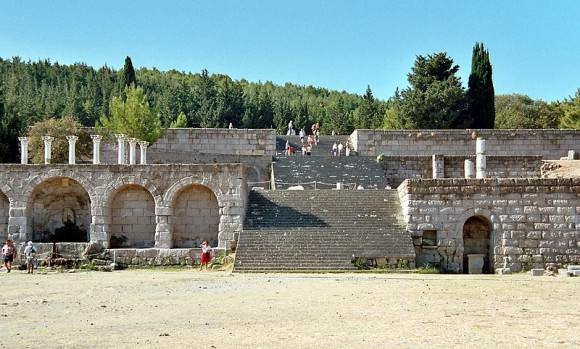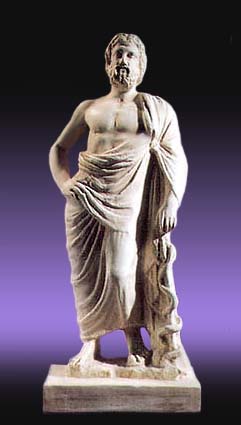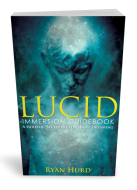
Dream incubation is the art of inviting a dream into your life for problem solving or healing. The term comes from the Latin incubare, which means to lie down upon, or as we say today: just sleep on it.
How does this relate to lucid dreaming? Lucid dreaming induction can be thought of a specific form of dream incubation in which we are not looking for a dream message, but a specific form of dream cognition: self-awareness mixed with the magical thinking of the dreamworld.
The Great Forgetting
The practice of dream incubation is well documented throughout the ancient world, with deep roots in our Western culture. Over the centuries, however, Christianity slowly began pulling away from the idea that dreams can contain wisdom, leading to a loss of this important ability.
But the writing is literally on the wall.

The work of archaeologists and classicists has reconstructed the Western practice of dream incubation based on ruins, documents and statues. During the Hellenistic era (the first three centuries of the Common Era), the practice took place in dream incubation temples that were staffed by priest-physicians.
In fact, dream temples made up the single most popular spiritual healing institution in the Mediterranean world. These restful sanctuaries were designed to produce dreams that provided healing wisdom—and also instant cures—if we are to believe the boasts of ancient graffiti.
The dream healers of ancient Greece were also surgeons and herbalists, teaching their young doctors the art of empirical observation coupled with an environment of safety and spiritual cleansing.
Hippocrates, the father of modern medicine, learned from his dream healing mentors to make empirical observations rather than simply following untested beliefs.
By the way, Hippocrates also wrote a medical dream dictionary that focused on a number of common dream symbols that indicate bodily ailments. So cool.
The divine figure associated with these dream temples is Aesclepius, the Greek god of healing. When doctors take the Hippocratic oath today, they still give thanks to Aesclepius and his daughters.
Aesclepius was commonly depicted standing with a large staff with a snake curling up it, identifying his origins as an earth spirit related to healing and the animal powers.
5 reasons why the ancient dream temples are relevant to lucid dreaming
• Sleeping practices. Clients slept on special ritual dreaming beds known as klines. More like a couch, the kline often included a stone neck or head rest, facilitating clients to elevate their heads and sleep on their backs. These sleeping styles are known today to encourage lighter sleep, more awakenings, as well as longer experiences in REM sleep. Given the universality of sleep biology, it seems as if Aesclepian temples directly encouraged vivid dreams as well as realistic hypnagogic hallucinations.
• Disruption of circadian rhythms. When those seeking healing crossed the threshold of the healing sanctuary, they entered an inner sanctum where sleep and prayer intertwined until a strong dream came. This pattern can also seen in Native American vision quests, where disrupted sleep (and attempts at night-long vigilance) leads to powerful visions often involving visitations with larger-than-life figures.
• Positive expectation. Clients hoped for and actively sought an interaction with a healing figure. Priests and priestesses also whispered in the ears of the sleepers to encourage dreams of Aesclepius. Today we know that dreams can incorporate sounds and suggestions into the dream narrative, as well as smells. LaBerge’s DreamLight may be considered a modern variation of this technique.
• Relaxation and cleansing. Before the intense dreaming incubations began, dreamers relaxed in baths, walked around the beautiful gardens around the temple, and took naps. They were removed from their everyday life in order to focus on healing. They also adhered to a cleansing diet while staying at the temples, further setting the stage for ritual purification in the final part of the healing process.
• Good dreamsigns. Snakes roamed the temple unmolested. As an ancient symbol of healing, snakes are at the center of the Aesclepian worldview. Dreams about snakes were taken to be dreams of Aesclepius himself. So, physician-priests made good use of the startling presence of snakes. According to lucid dreaming educator Tim Post, this is the perfect example of an effective dreamsign: one that is focused, meaningful and has an element of the bizarre.
Introducing Lucid Immersion
 This article is drawn from the Lucid Immersion Guidebook. Drawing from the wisdom of dream cultures like the Aesclepian sanctuaries, as well as the latest in lucid dreaming research, Lucid Immersion Guidebook sets you up with a container of mindful and structured rituals to effectively stimulate greater self-awareness in the dreamworld…. and waking life.
This article is drawn from the Lucid Immersion Guidebook. Drawing from the wisdom of dream cultures like the Aesclepian sanctuaries, as well as the latest in lucid dreaming research, Lucid Immersion Guidebook sets you up with a container of mindful and structured rituals to effectively stimulate greater self-awareness in the dreamworld…. and waking life.
Ryan, this is a great article with facts about dream incubation I’ve never heard before … such as Hippocrataes’ medical dream dictionary! Where can I learn more about that? Any references?
Thanks for the informative blog, and I look forward to the December 8th download. One question … the photo says Lucid Immersion Guidebook and the text of the blog says Lucid Immersion Blueprint. Are these the same, or is there also a Guidebook that will be available for download?
Best wishese,
Laurel
Hi Laurel!
Kelly Bulkeley discusses Hippocrates’ medical dream dictionary in his Dreaming in the World’s Religions. Hippocrates’ text was called On Regimen. (this 5th century treatise covers more than dreams, it included many symptoms of acute diseases; and also, some scholars dispute if Hippocrates wrote it or if his students did…). For more analysis, see Dodd’s (1951) The Greeks and the irrational.
And good eye about the image! The entire program is the Lucid Immersion Blueprint, and the chief text is the Lucid Immersion Guidebook. more details soon!